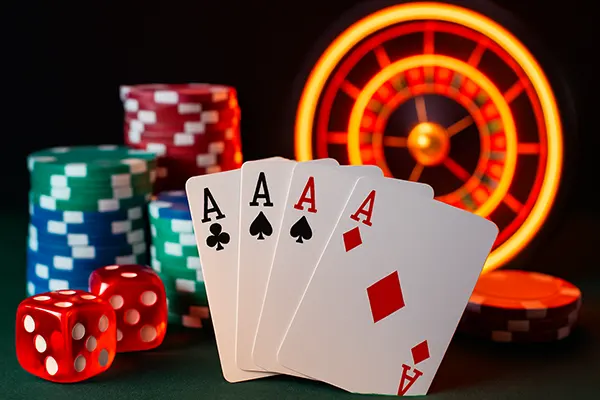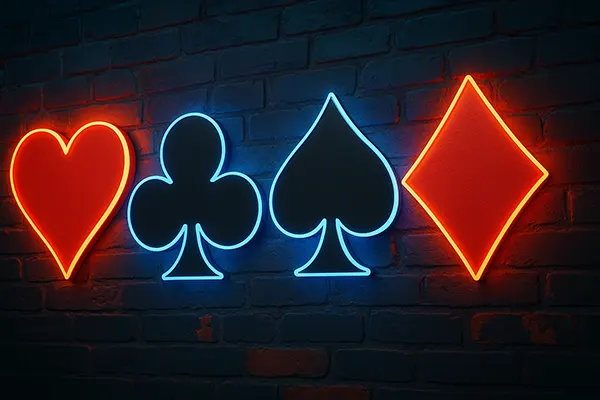
Cards, Chips and Dice: How Gambling Symbolism Entered Modern Design and Graphics
Symbols once confined to casinos—card suits, chips, dice, and roulette wheels—are now part of mainstream visual language. Designers adopt these elements for their strong geometry, bold colours, and cultural resonance, using them in branding, posters, digital art, and fashion without explicit reference to gambling. Their transformation reflects how modern design reinterprets traditional symbols to create new meanings.
Gambling Motifs in Branding and Visual Identity
Card suits are among the most recognisable symbols globally, making them valuable tools in brand design. Their simple forms allow designers to craft minimalist icons, monograms, and repeating patterns that subtly suggest structure and order. These motifs are often used in sportswear logos, event branding, and packaging to evoke sophistication and playfulness simultaneously.
Chips and roulette wheels have become popular as abstract graphic elements, especially in marketing for entertainment or nightlife sectors. Their circular shapes symbolise continuity, energy, and dynamic movement, which aligns with the visual identity goals of many modern brands seeking a bold, energetic aesthetic.
Even without direct references to gambling, these symbols serve as metaphors for risk-taking and strategic thinking. Companies in sectors like finance or technology occasionally integrate subtle card or dice motifs into their logos to convey innovation, calculated risk, and forward thinking.
Minimalist vs. Neon Retro Aesthetics
Two primary stylistic directions dominate how gambling symbols are used today: minimalism and neon retro. The minimalist approach reduces shapes to clean lines and flat colours, ideal for digital interfaces, apps, and corporate branding. This style strips symbols of their gambling associations, turning them into purely aesthetic elements.
Conversely, neon retro design revives the visual spirit of mid-20th-century Las Vegas—bright neon lights, glowing outlines, and vibrant contrasts. Designers use glowing dice, chips, and card suits to create nostalgic atmospheres for music events, clubs, and themed exhibitions. This approach celebrates the cultural heritage of gambling design while giving it a contemporary twist.
These contrasting aesthetics show how versatile gambling symbols have become, fitting seamlessly into either sleek modern branding or bold vintage-inspired visuals depending on the project’s tone and audience.
Use of Gambling Icons in Contemporary Art
Modern artists increasingly incorporate gambling symbols into their works as commentary on chance, risk, and consumerism. Card suits appear as abstract motifs in paintings, installations, and sculptures, often stripped of numerical values to emphasise form and colour rather than gameplay.
Dice are frequently used as conceptual objects symbolising unpredictability. Some artists create oversized dice sculptures to provoke reflection on randomness in everyday life, while others paint them in surreal or fragmented compositions to challenge traditional perceptions of order and chaos.
Chips and roulette wheels are often portrayed in pop art and street art as symbols of wealth and fleeting fortune. Their repetition across artworks echoes mass production, hinting at the commodification of luck and the blurring lines between entertainment and consumer culture.
Examples of Symbolic Reinterpretation
One notable example is the work of French graphic artist Malika Favre, who has integrated card suits into fashion-themed illustrations, recontextualising them as elements of pattern and geometry. Her work demonstrates how these symbols can convey elegance without any gambling connotation.
Contemporary street artist Okuda San Miguel has used giant dice and chips in public installations to question society’s obsession with chance and luck. His vibrant, polygonal style transforms these objects into colourful icons of human decision-making.
In digital art, creators on platforms like Behance and Dribbble often showcase conceptual projects where poker chips and roulette wheels are abstracted into geometric patterns, using them as purely visual devices rather than thematic content, further confirming their integration into modern design vocabulary.

The Cultural Shift Behind the Trend
The adoption of gambling symbols in design reflects broader cultural changes. As society embraces gamification in education, marketing, and workplace systems, symbols of play have gained neutral or even positive connotations. They no longer imply vice but rather strategy, competition, and achievement.
This cultural shift also aligns with the nostalgia trend in design. Neon lights, retro casino typography, and vintage dice evoke mid-century Americana, appealing to audiences seeking authentic, retro-inspired visuals while being detached from actual gambling activities.
Moreover, globalisation and digital culture have diluted the original meanings of these symbols. A spade or a chip in a logo can now signify energy, style, or boldness rather than gambling, allowing designers to tap into their aesthetic qualities without inheriting their ethical baggage.
Future of Gambling Symbolism in Design
Looking ahead, gambling symbols are likely to become even more abstract and stylised. As generative design tools and AI-driven visual systems evolve, designers can manipulate these motifs into new forms while preserving their recognisability, enabling their use across diverse industries from fashion to fintech.
We may also see more cross-cultural reinterpretations, with traditional Western gambling icons merging with motifs from other cultural games, broadening their visual language and appeal. This fusion will enrich the symbolic palette available to contemporary designers.
Ultimately, the future of these symbols lies in their versatility. Freed from their original meaning, cards, chips, and dice are now part of a universal visual vocabulary, offering designers powerful tools to communicate concepts of chance, movement, and ambition.
